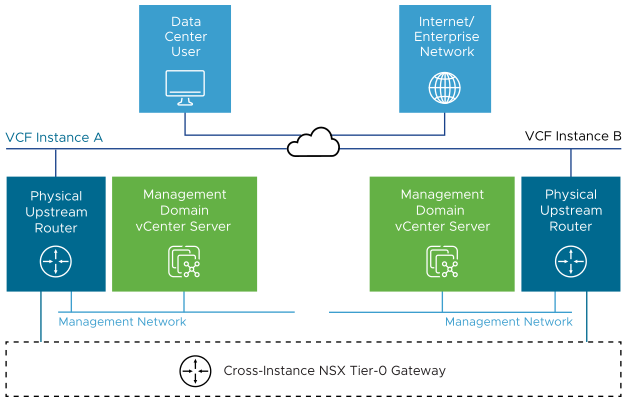You place vCenter Server on a VLAN for traffic segmentation, and decide on the IP addressing scheme and name resolution for optimal support for the SDDC management components and host management in VMware Cloud Foundation.
Network Segments
For secure access to the vSphere Client and vCenter Server APIs, the management domain vCenter Server is connected to the management VLAN. For information on the network segments in VMware Cloud Foundation, see Distributed Port Group and VMkernel Adapter Design for the Management Domain.

Decision ID |
Design Decision |
Design Justification |
Design Implication |
|---|---|---|---|
VCF-MGMT-VCS-NET-001 |
Place the appliance of the management domain vCenter Server on the management VLAN network segment. |
Reduces the number of required VLANs because a single VLAN can be allocated to both, vCenter Server and NSX-T for Data Center management components. |
None. |
IP Addressing
You must assign a static IP address for the management domain vCenter Server. Following industry best practices, VMware Cloud Foundation does not allow using DHCP to assign IP addresses to the management components, including the management domain vCenter Server.
Decision ID |
Design Decision |
Design Justification |
Design Implication |
|---|---|---|---|
VCF-MGMT-VCS-NET-002 |
Allocate a statically assigned IP address and host name to the appliance of the management domain vCenter Server. |
Ensures stability across the SDDC, makes it simpler to maintain and track, and to implement a DNS configuration. |
Requires precise IP address management. |
Name Resolution
Name resolution provides the translation between an IP address and a fully qualified domain name (FQDN), which makes it easier to remember and connect to components across the VMware Cloud Foundation instance. Each IP address must have valid internal DNS registration which includes forward and reverse name resolution. vCenter Server systems must be connected to the following components:
Systems running vCenter Server add-on modules
Each ESXi host
NSX Manager cluster
Internal DNS servers for name resolution of other management components
Decision ID |
Design Decision |
Design Justification |
Design Implication |
|---|---|---|---|
VCF-MGMT-VCS-NET-003 |
Configure forward and reverse DNS records for the appliance of the management domain vCenter Server. |
The vCenter Server appliance is accessible by using a fully qualified domain name instead of by using an IP address only. |
You must provide DNS records for the vCenter Server appliance. |
Time Synchronization
Time synchronization provided by the Network Time Protocol (NTP) is important to ensure that all components within the VMware Cloud Foundation instance are synchronized to the same time source.
Decision ID |
Design Decision |
Design Justification |
Design Implication |
|---|---|---|---|
VCF-MGMT-VCS-NET-004 |
Configure time synchronization by using an internal NTP time for the appliance of the management domain vCenter Server. |
|
|